Wrybills, the little shore birds with a bend in their beak, are only found in New Zealand. They breed on the South Island’s braided rivers with well-camouflaged eggs and chicks to help protect them from flying predators. But camouflage is no protection against mammal predators who hunt by scent.
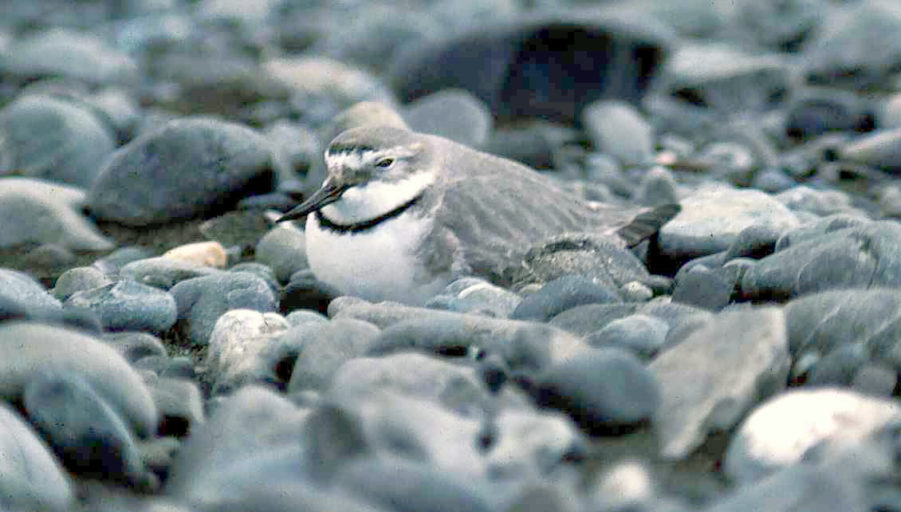
Does predator control help improve survival and breeding success of wrybills? Researchers John Dowding, Elaine Murphy and Mike Elliott carried out a study from 1997-2000, with the results only recently published in Notornis, the research journal of Birds New Zealand.
“Our study aimed to measure survival and productivity of wrybills in the Tekapo and Tasman Rivers, Mackenzie Basin, South Canterbury, and to compare these parameters between areas with and without trapping to determine whether control of mammalian predators was associated with enhanced breeding success and/or survival. The study was conducted over three breeding seasons (September to January 1997/1998, 1998/1999, and 1999/2000).”
The wrybill plover (Anarhynchus frontalis) is classified internationally as Vulnerable and by the New Zealand threat classification scheme as Threatened (Nationally Vulnerable).
“Wrybills currently breed only in braided rivers east of the main divide in the South Island, from the Waiau River, North Canterbury to the Dart River in northern Otago. Within this range, the bulk of the population is found in three large catchments: the Rakaia River, the upper Rangitata River, and the Mackenzie (Upper Waitaki) Basin. Following breeding, birds migrate to the North Island and most of the population winters in the large harbours around Auckland.”
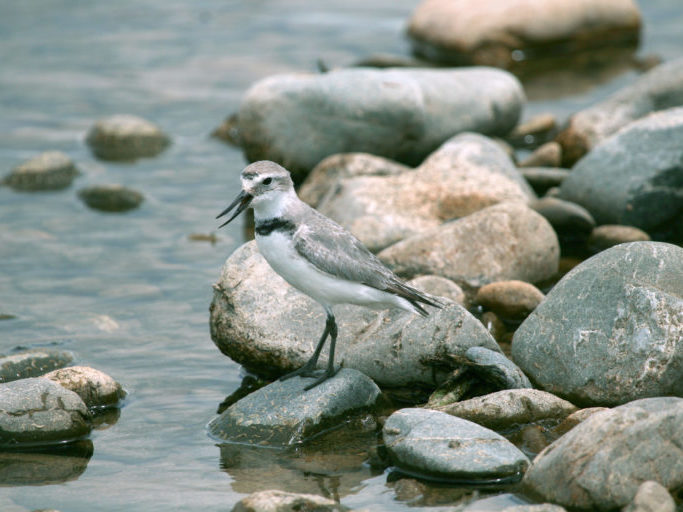
The population is probably about 5,000–5,500 birds.
“The main threats to the species appear to be loss or degradation of breeding habitat, loss of nests or small chicks to flooding, and predation by introduced mammals and native birds, but the relative importance of these threats is unknown.”
Predator trapping has been carried out by DOC in the Mackenzie Basin since the 1980s to protect the critically endangered black stilt, but other riverbed species such as wrybills are likely to have benefited too.
“Two study sites were located in the Tasman River and two in the Tekapo River. The locations and sizes of the sites were dictated largely by the distribution and density of wrybills in the two rivers, and by accessibility. There were obvious differences in habitat type between the two rivers, and the use of two sites in each was an attempt to control for this. The bed of the Tekapo River is generally narrower (mainly between 200 and 800 metres in width) than that of the Tasman and contains more vegetation. The bed of the Tasman is very wide (2.5–3.5 km) and contains much larger areas of open gravel.”
Predator control was undertaken during the bird breeding season, between September and January.

“During each of the three breeding seasons, adults and chicks were caught and fitted with individual colour-band combinations consisting of a numbered metal band and 3 or 4 plastic colour bands. Adults were sexed by the presence (males) or absence (females) of a narrow black frontal bar between the forehead and crown. Most pairs being monitored contained one or two colour-banded birds, which allowed families to be monitored when they sometimes moved away from the nest area after hatching.”
Wrybill nests are almost impossible to spot, with eggs perfectly matching the river stones that surround them.
“Nests were found by watching from a distance as birds returned to them. Pairs were normally monitored every 2–4 days, but intervals were occasionally longer (e.g., when a pair had recently lost a clutch or brood and no activity was expected). Nests were monitored by walking past them (as opposed to up to them and back) in an attempt to avoid leaving scent trails that might be followed by mammalian predators.”
The researchers were interested in both nesting success and adult survival.
“Nesting success was the proportion of nests that hatched one or more eggs. Nest outcomes were recorded as
- Hatched (at least one chick seen);
- Flooded (eggs disappeared from the nest before they were due to hatch and following a flood that reached the nest);
- Abandoned (not seen to be incubated during multiple visits and failed to hatch);
- Depredated (eggs disappeared and nest bowl contained yolk and shell fragments, or eggs disappeared before they were due to hatch and nest had not been flooded or abandoned);
- Unknown. In a very few cases, adult behaviour (agitation, vocalisation, and distraction displays) indicated nesting but the nest could not be found, and breeding was not confirmed until small chicks were seen.”
Chicks are so well camouflaged, that the researchers found it easier to locate them at night than during the day
“Chicks were often hard to find by day, but the presence of one or more could be inferred from parental distraction behaviour. The number of chicks present could be determined either by torchlight searches at night (when chicks were very active), or by waiting until fledging, when they ceased hiding and were obvious. Fledging success was the proportion of chicks hatched that fledged. Minimum productivity was the mean number of chicks definitely known to have fledged per breeding pair.”
A total of 181 breeding adults (91 females and 90 males) were individually colour banded during the study. Researchers could also identify other breeding birds from a combination of location and metal bands applied in another study.
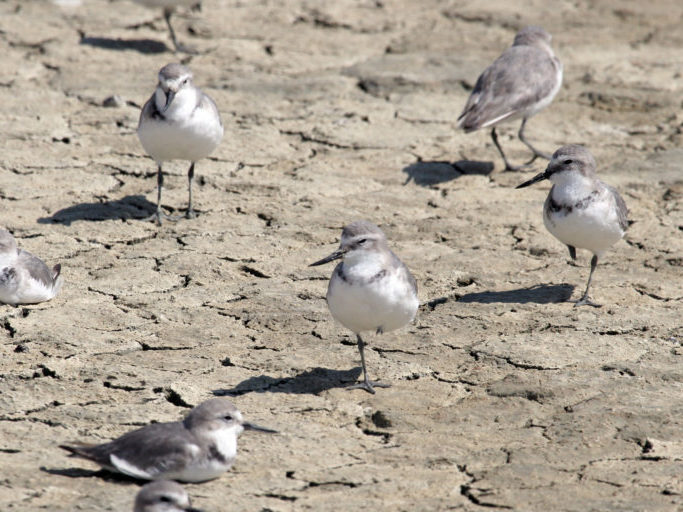
“Annual adult survival was determined (as Minimum Number Alive from one year to the next) by recording the presence or absence of colour-banded individuals in Auckland-area post-breeding flocks in February or March each year. Some individuals were not seen at these flocks (which together hold about 85% of the wintering population); status of these individuals was noted when they returned (or did not return) to breeding sites in August or September. Wrybills display very high fidelity to both breeding site and wintering site.”
The proportion of nests that hatched varied from 47.8% to 76.1% between sites over the 3 breeding seasons of the study. It was lowest in the upper Tasman where no trapping was carried out. So was predation to blame?
“Combining all sites, 13 nests were lost to flooding; 7 of these were lost in a single event in the Tekapo River in Nov 1998, when a high flow of water was deliberately discharged down the river from Lake Tekapo over a period of 5 weeks. In the Tasman River (where flows were not controlled), floods accounted for the loss of only 6 (4.3%) of 138 nests. In all, 14 nests were abandoned, and in 6 of those cases abandonment was accompanied by the permanent disappearance of a colour-banded adult from the pair. Depredation was the largest cause of nest failure, accounting for at least 40 (56%) of the 72 nests that did not hatch. Loss of nests to depredation was highest by far in the upper Tasman.”
When it came to fledging success and productivity, the upper Tasman (no trapping) was again much lower than the other sites.
“Overall fledging success was similar between years (range 30.4–42.4%) but there were differences between sites. Success was similar in the two Tekapo sites and the lower Tasman but, as for nesting success, was markedly lower in the upper Tasman. Productivity of wrybills was generally consistent between years at each site, but also varied considerably between sites. Over all sites and years, productivity averaged 0.49 chicks fledged per pair. However, productivity was particularly low in the upper Tasman site in both years it was measured, and if that site is excluded, productivity in the other three sites averaged 0.61.”
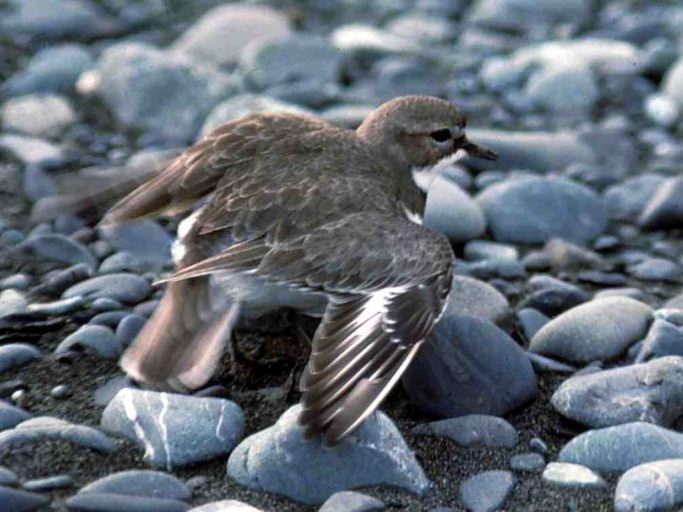
Trapping predators seemed to make a large difference in the Tasman River, but little noticeable difference in the Tekapo.
“Combining years, there were differences between sites in the two rivers in the number of pairs successfully fledging one or more chicks. In the Tekapo, 17 (61%) of 28 pairs were successful in the un-trapped area and 21 (54%) of 39 were successful in the trapped area; this difference was not significant. In the Tasman, only 5 (11%) of 46 pairs fledged chicks in the un-trapped area and 32 (40%) of 80 pairs fledged chicks in the trapped area; this difference was highly significant.
Lack of trapping in the upper Tasman also appears to have left adults at risk.
“Survival of both males and females was lower in the upper Tasman than in any of the other 3 sites. When banded adults disappeared, the cause of death was normally unknown. However, direct evidence of adult predation came from a subsequent study in the Tasman River in which the remains of 7 colour-banded wrybills from the present study were found in stoat dens.”
Adult males were more likely to be killed than females, probably because the male wrybill does most of the incubation and brood-rearing duties at night, which is also when many of the mammalian predators are most active. Harrier hawks and black-backed gulls are also, however, potential predators of wrybill nests and chicks during daylight.
“Combining seasons, annual survival of females was higher than survival of males at all four sites. Overall, annual survival of females (0.818) indicated average life-expectancy of 5.0 years, and annual survival of males (0.710) indicated life expectancy of 3.0 years.”
So what do results mean for wrybill population numbers?
“At the time of our study, the intrinsic capacity for increase in the two Tekapo sites was similar and suggested a potential decline in that river’s local population of about 5% per year. In the upper Tasman, r was strongly negative and in the absence of immigration, suggested an annual decline of about 27.5%. The trapped lower Tasman site was the only population in which r was positive, with a potential annual increase of 3.5%.”
The data showed more losses at the chick stage than at the egg stage and only a weak correlation between nesting success (chicks hatched) and productivity.
“We therefore suggest that nesting success (which is much easier to measure than productivity) should not be used as a proxy for overall breeding success. There are obvious reasons why chicks and eggs may show different levels of susceptibility to various threats. First, they may be vulnerable to different predators; for example, hedgehogs prey on many shorebird nests in the Mackenzie Basin but are too slow to catch most shorebird chicks, which are precocial and highly mobile. Because they are mobile, chicks may be more susceptible to avian predators, which hunt largely by sight.”
“Being mobile and able to swim well, wrybill chicks often survive floods that destroy nests. Like most shorebird chicks, wrybills are not fed by their parents, so even short periods of low food availability could adversely affect chick survival, while having little impact on egg survival.”
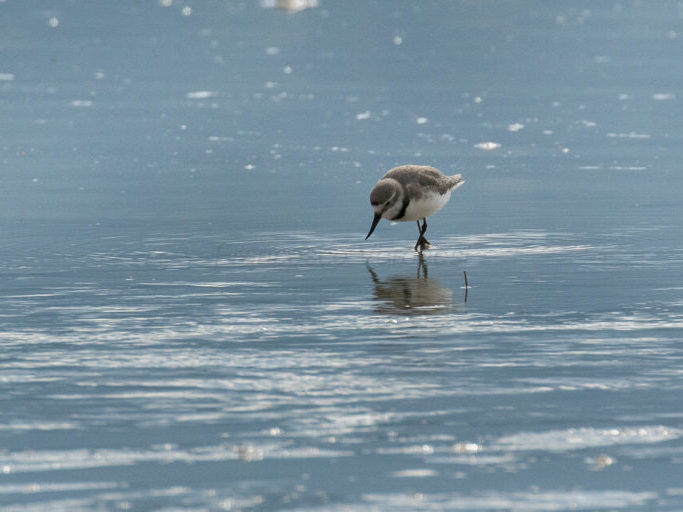
So why might predator control have made a big difference to hatching success, fledging success and productivity in the Tasman River, but had little effect in the Tekapo River?
“The study areas in the Tasman and Tekapo Rivers were originally chosen as replicates, but trapping data subsequently suggested there were differences in the abundance of some predators between the rivers. Stoat captures were higher in the Tasman than in the Tekapo in all years. Cat captures were broadly similar between the rivers in years 1 and 2 but were higher in the Tasman in year 3. There were no consistent differences between the rivers in catch rates of ferrets, hedgehogs, or rats.”
Predation pressure from stoats (in all years) and cats (in year 3) may therefore have been higher in the Tasman.
“The suggestion that stoats may have been having an impact on wrybills in the Tasman is supported by a study of stoat diet there undertaken immediately following this study. Over a two-year period, 17 (7.8%) of 219 stoat dens excavated contained wrybill remains. The 24 adult wrybills found in those dens accounted for about 20% of the adult wrybill population in the river at that time, and because not all stoat dens would have been found, the figures will be underestimates.”
Rabbits may, indirectly, be part of the problem.
“Rabbits are a staple in the diet of cats, ferrets, and stoats in the Basin, and it has been suggested that large changes in rabbit densities (brought about by trapping, poisoning, and rabbit haemorrhagic disease), have resulted in periodic shifts in predator diet, leading to more birds being eaten.”
“Our finding that trapping increased survival but not productivity of wrybills in the lower Tasman site suggests that measuring productivity alone may provide only a partial indication of the effectiveness of management.”
Like other New Zealand plovers, wrybills are long-lived – the oldest known wrybills are about 25 years old.
“In longlived species, values of ‘r’ (intrinsic capacity for increase) are particularly sensitive to changes in adult survival, and measuring adult survival as well as productivity is therefore important (a) to gain a more complete measure of whether predator control is beneficial and (b) to assess population trends.”
Low breeding success may not always be a result of mammalian predation – flooding alone can cause almost total breeding failure for a season in a river. Food may be in short supply one year or avian predators active.
“Predator control may therefore not always be beneficial. Trapping was beneficial during our study, but only in one of the two rivers. Our understanding of the factors governing the distribution of mammalian predators in braided river systems, and of the reasons behind temporal changes in predator density that may occur in those systems, is limited. In addition, the response of different bird species to mammalian predator control may differ and the relative importance of avian and mammalian predation may vary between sites and years. Further research is required to refine management protocols for braided river bird species and to decide where, when, and on what scale management should be undertaken to halt or reverse declines in range and numbers.”
The full research paper is published in Notornis. Only the abstract is freely available to non-subscribers until 1 year after publication.

